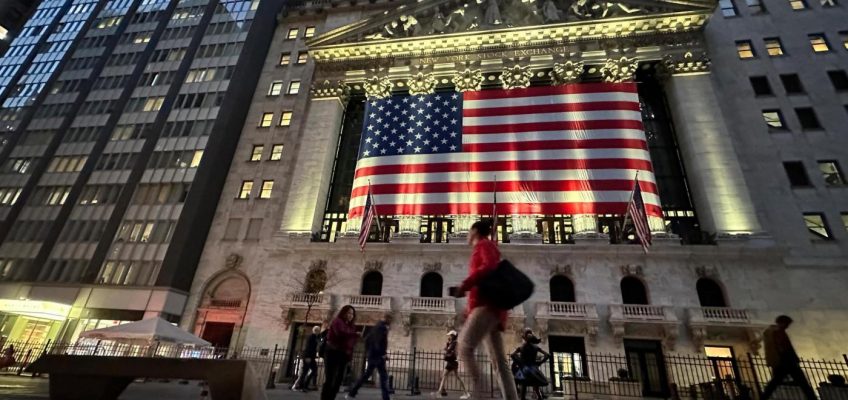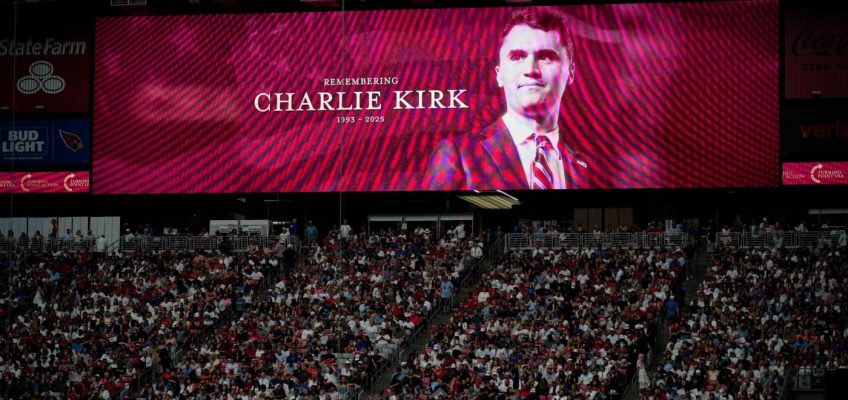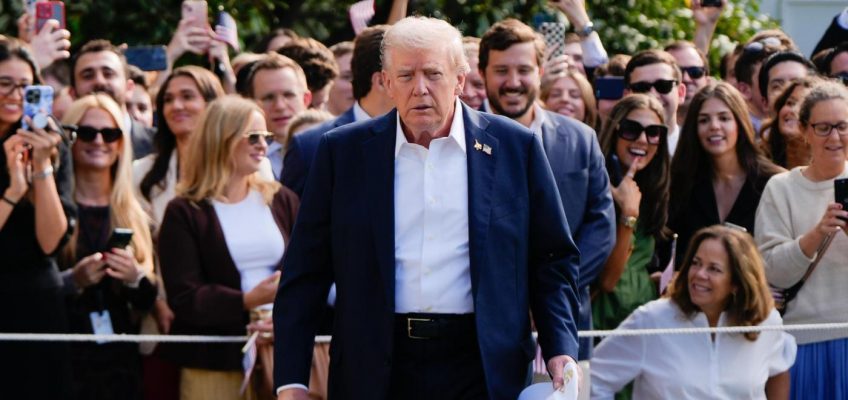By ADAM GELLER and SAM MEDNICK, Associated Press
Days after his defiant speech at the United Nations rejecting demands to end the war in Gaza, Israeli Prime Minister Benjamin Netanyahu is set to confer with his most important supporter.
But Monday’s meeting with President Donald Trump in Washington comes at a tenuous moment. Israel is increasingly isolated, losing support from many countries that were long its steadfast allies. At home, Netanyahu’s governing coalition appears more fragile than ever. And the White House is showing signs of impatience.
The question now is whether Trump, who has offered steadfast backing to Netanyahu throughout the war, will change his tone and turn up the pressure on Israel to finally wind down the conflict.
With scant information, federal workers brace for possible shutdown
Trump’s comments on autism evoke anger and hope among autistic people and their families
Trump to meet Monday with top four congressional leaders as government shutdown risk looms
A broad wave of firings followed Charlie Kirk’s assassination
Trump’s trade battle with China puts US soybean farmers in peril
In a post Sunday on social media, the president said: “We have a real chance for GREATNESS IN THE MIDDLE EAST. ALL ARE ON BOARD FOR SOMETHING SPECIAL, FIRST TIME EVER. WE WILL GET IT DONE!!!”
Trump and Netanyahu are scheduled to meet in the Oval Office, and a joint press conference is expected later.
The uncertainty surrounding the meeting casts it as “one of the most critical” in the yearslong relationship between the two leaders, said professor Eytan Gilboa, an expert on US-Israeli relations at Bar-Ilan and Reichman universities.
“Netanyahu might have to choose between Trump and his coalition members,” a number of whom want the war to continue, Gilboa said. A move by Netanyahu to end the war would leave him on shaky political ground at home a year before elections.
Oded Ailam, a researcher at the Jerusalem Center for Security and Foreign Affairs, agreed that Trump is likely to demand a permanent ceasefire, leaving Netanyahu with few options. Netanyahu has repeatedly vowed to continue the offensive until Hamas is destroyed.
Israel could seek to include ‘red lines’
If Trump puts the pressure on, the Israeli leader would probably seek to include “red lines” in any deal, Ailam said. He might demand that Hamas be dismantled, Ailam said. Netanyahu might also set a condition that if the militant group resumes fighting or returns to power, the Israeli military would have the right to operate freely in Gaza, he said.
Trump joined forces with Netanyahu during Israel’s brief war with Iran in June, ordering U.S. stealth bombers to strike three nuclear sites, and he’s supported the Israeli leader during his corruption trial, describing the case as a “witch hunt.”
But the relationship has become more tense lately. Trump was frustrated by Israel’s failed strike this month on Hamas officials in Qatar, a U.S. ally in the region that had been hosting negotiations to end the war in Gaza.
Recent comments have hinted at growing impatience from Washington. Last week, Trump vowed to prevent Israel from annexing the West Bank — an idea promoted by some of Netanyahu’s hard-line governing partners. The international community opposes annexation, saying it would destroy hopes for a two-state solution.
Michael Doran, senior fellow at the Hudson Institute, dismissed the idea that Trump’s comments about the West Bank were a sign of friction. He said the remarks allowed Netanyahu to resist pressure from right-wing members of his government.
“That was a clever move by Trump,” Doran said. “It simultaneously showed responsiveness to Arab and Muslim allies while actually helping out Netanyahu.”
On Friday, Trump raised expectations for the meeting with Netanyahu, telling reporters on the White House lawn that the U.S. was “very close to a deal on Gaza.”
Trump has made similar pronouncements in the past with nothing to show for it, and it’s unclear if this time will be different.
Proposal does not include expulsion of Palestinians
Trump’s proposal to stop the war in Gaza calls for an immediate ceasefire, the release of all hostages within 48 hours and a gradual withdrawal of Israeli forces from the Palestinian enclave, according to three Arab officials briefed on the plan. They spoke on condition of anonymity because the plan has not been formally unveiled.
Hamas is believed to be holding 48 hostages, 20 of whom are believed by Israel to still be alive. The militant group has demanded that Israel agree to end the war altogether and withdraw from all of Gaza as part of any permanent ceasefire.
Trump discussed the plan with Arab and Islamic leaders in New York on the sidelines of the U.N. General Assembly. It doesn’t include the expulsion of Palestinians from Gaza, which Trump appeared to endorse earlier this year.
The 21-point proposal also calls for an end to Hamas rule of Gaza as well as the disarmament of the militant group, the officials who were briefed on the plan, said. Hundreds of Palestinians, including many serving life sentences, will be released by Israel, according to the proposal.
The plan also includes the establishment of an international security force to take over law enforcement in post-war Gaza, they said.
A Palestinian committee of technocrats would oversee the civilian affairs of the strip, with power handed over later to a reformed Palestinian Authority, they said. Netanyahu has rejected any role for the authority, the internationally recognized representative of the Palestinians, in postwar Gaza.
A Hamas official said the group was briefed on the plan but has yet to receive an official offer from Egyptian and Qatari mediators. The group has repeatedly rejected laying down arms and has linked its weapons to the establishment of an independent Palestinian state.
Netanyahu acknowledged the U.S. plan Sunday in an interview with Fox News, saying Israeli officials were “working with President Trump’s team … and I hope we can make it a go.”
In his speech Friday at the U.N., Netanyahu praised Trump multiple times, calling him an essential partner who “understands better than any other leader that Israel and America face a common threat.”
Israel has lost much of the world’s goodwill
But apart from the U.S. leadership, Israel has lost much of the international goodwill it once could count on.
At a special session of the U.N. Security Council last week, nation after nation expressed horror at the 2023 attack by Hamas militants that killed about 1,200 people in Israel, saw 251 taken hostage and triggered the war. Then many of the representatives went on to criticize the response by Israel and call for an immediate ceasefire in Gaza and influx of aid.
Israel’s sweeping offensive has killed more than 66,000 Palestinians in Gaza, according to the Gaza Health Ministry, which is part of the Hamas-run administration. Its figures are seen as a reliable estimate by the U.N. and many independent experts. The fighting has displaced 90% of the Gaza population, with an increasing number now starving.
In recent weeks, 28 Western-aligned countries that circled behind Israel two years ago have called on it to end the offensive in Gaza. They also criticized Israel’s restrictions on humanitarian aid, which have contributed to famine in parts of Gaza.
Ten countries — including Britain, France, Canada and Australia — recognized Palestinian statehood last week, hoping to revive the long-moribund peace process. Several Arab states, including some with longstanding relations with Israel, have accused it of committing genocide in Gaza, as have leading genocide scholars, U.N. experts and some Israeli and international rights groups. The U.N’s highest court is weighing genocide allegations raised by South Africa that Israel vehemently denies.
Aaron David Miller, who served as an adviser on Middle East issues to Democratic and Republican administrations, said there were too many unresolved issues to believe that an end to the conflict is near.
“The more crowing that is done about how we’re in the final stages, the more skeptical I become,” he said.
Geller reported from New York, and Mednick reported from Jerusalem. Associated Press writers Sam Magdy in Cairo; Joseph Krauss in Ottawa, Ontario; and Chris Megerian in Washington contributed to this report.




